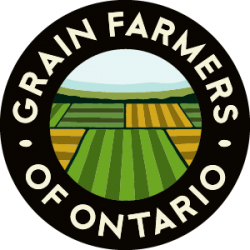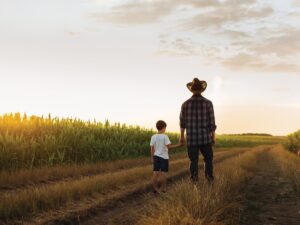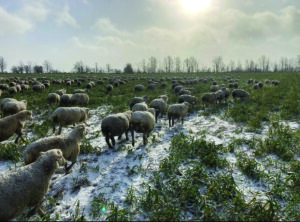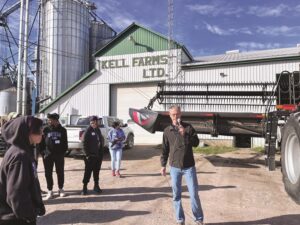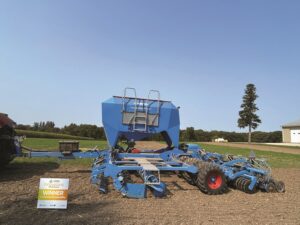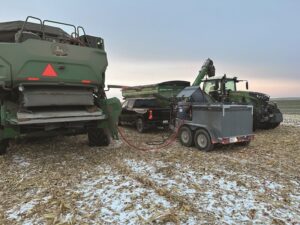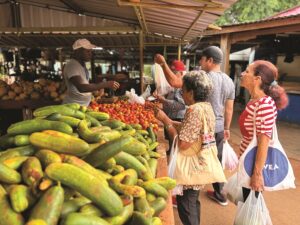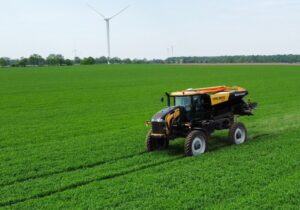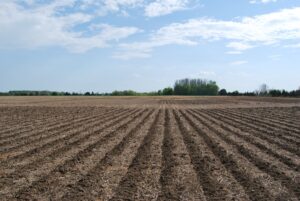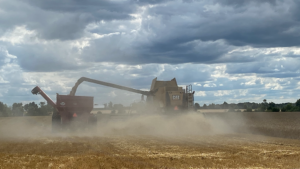Winning yield is 74 bushels per acre
SOYBEAN YIELD CHALLENGE WINNERS SHARE THEIR SECRETS TO THEIR WINNING YIELDS
what some are deeming “the perfect growing season” has yielded an impressive crop of Soybean Yield Challenge winners. The nine winners were announced and prizes awarded recently at the Soybean Yield Challenge banquet.
“This is the biggest year yet,” says Crosby Devitt, Manager of Research and Market Development with Grain Farmers of Ontario. “We had 60 entrants that completed the competition,” he continues. These numbers are an increase from last year where 34 entrants completed the challenge.
the winners and the prizes
Challenge competitors were separated into three different zones based on crop heat units. A winner and two runners up were recognized in each zone.
Zone 1 – 2700 CHU and under
Winner Scott Thompson St Mary’s, NK S05-T6,
71.56 bushels per acre
Runners Up Dave VanderBorgh, Wroxeter,
OAC Drayton, 67.77 bushels per acre
John & Beth Nanne, Pakenham,
NK S05-T6, 66.21 bushels per acre
Zone 2 – 2750 to 3000 CHU
Winner Gordon Barrie & Sons, Bowmanville,
Pioneer 91Y90, 74.15 bushels per acre
Runners Up Frank Van Der Burg, Lancaster,
Dekalb 281RY, 72.22 bushels per acre
R&J Fraser Farms, Ottawa,
Pioneer 91Y90, 70.04 bushels per acre
Zone 3 – 3000 CHU and above
Winner Mailloux Farms, Amherstburg,
Pioneer 93Y20, 71.98 bushels per acre
Runners Up Joseph Vanek, Chatham, NK S23-T5, 70.19 bushels per acre
Jon-Ern Farms, Blenheim, 5221RR2Y, 69.48 bushels per acre
Winners in each zone received a cash prize of $10 x their yield in bushels plus admission to the 2011 Canada’s Outdoor Farm Show and their local farm show (London, Toronto or Ottawa).
Runners Up in each zone received admission to the 2011 Canada’s Outdoor Farm Show and their local farm show.
The overall winner, Gordon Barrie & Sons, will receive a trip to the National Farm Machinery Show in Louisville, Kentucky.
the perfect season
With an average yield of 61.6 bushels per acre among all challenge participants, there are lots of questions about what factors lead to such a phenomenal year.
“We have to keep things in perspective. 2010 was the best year we’ve ever had for soybeans,” says Horst Bohner, Soybean Specialist with the Ontario Ministry of Agriculture, Food and Rural Affairs. “It blew the top off in terms of heat unit accumulation and for those that got it, precipitation at critical growing times were excellent. In terms of overall provincial average it’s going to be a record.”
gordon barrIE & sons
Grand prize winner, Tom Barrie from Gordon Barrie & Sons, agrees with Bohner’s sentiment; “You couldn’t ask for a better season. That’s half the battle of getting a good crop is to have perfect growing conditions.”
In addition to a great season, Barrie, who farms with his brothers, Steve and Glenn, chose his field and his variety very carefully for the challenge. “The 74 bushels was not unexpected from that field. Historically it has given us top yields.”
He also credits his soil and his rotation to his success this year. “Crop rotation is the key in our program. We historically only grow beans once every five years so there is no disease build up,” says Barrie. A typical rotation on the Barrie farm includes corn, soybeans, canola followed by wheat which is under-seeded with
red clover.
The field chosen for the challenge has also benefited from the Barrie’s no till practices. “It’s been 16 years in no-till. The soil structure on that field is incredibly good,” says Barrie. “There’s no compaction and lots of organic matter.”
Barrie planted Pioneer 91Y90 on May 17.
scott thomson
Winner from Zone 1 also credits Mother Nature for his big win. “It was the right year with the right weather,” says Thomson. “The timing was great. The beans never stopped growing.”
Although he didn’t manage his field very differently this year compared to other years, he confirms that he chose his field carefully. “The year prior was corn and nine to 10 years before that it was hay
and pasture,” he says. “It had a high level of organic matter and it’s tiled and
well-drained.”
By mid-season, Thomson knew he had a winning crop. “The beans were four feet tall in some places. They were tall and very well podded.”
He uses conventional tillage and planted NK 205-T6 using a corn planter on May 19.
mailloux farms
Management on the winning field on Mailloux Farms was certainly out of the norm this year. “It was sort of an off-the-cuff decision,” says Josh Mailloux of his decision to plant on April 24. “I had the corn planter out and I heard some neighbours were planting soybeans so I thought I’d give it a try.”
Although the majority of the farm is usually no-till, the winning field was tilled in anticipation of seed corn. When they decided against using that field for seed corn, Pioneer 93Y20’s were planted in 30 inch rows.
Following with the theme of change, the Mailloux’s even diverted from their typical rotation. “It was planted to beans after wheat stubble,” says Mailloux. “We typically do corn-soybeans -wheat.”
Although much was different in their management strategy for this particular field, Mailloux credits the decision to plant early. “We’ve never planted in April before. But, we had heavy rain in June and July. Any other beans that weren’t far along were hurt pretty badly. The beans in this field were big enough to handle the water stress.”
“Next year if Mother Nature cooperates in April, I’m going to try to do the same thing,” says Mailloux.
managing stress
Mailloux’s success with early planting is not an anomaly. In many of Bohner’s research trials, he found that an early planting date resulted in the greatest and most consistent yield impact. “On average we lost four bushels going from the last weeks of April to the second week of May. Going from the last week of April to the last week of May, we lost nine bushels,” says Bohner.
The research this year also demonstrated that some varieties have a stronger response to early planting.
“This year early planting really paid off. Whether or not it’s going to pay off every year – we know that’s not the case,” concludes Bohner.
By just looking at the winners – as both Barrie and Thomson planted in mid-May – it’s obvious that early planting is only one factor in gaining a high yield crop.
For this year, Bohner notes that management practices made less of an impact. “The growing conditions were so good that other management decisions in terms of inputs were less important than in other years.”
This observation is reflected in Bohner’s high yield trials. “You have to focus in on what the stress is on an individual field,” says Bohner. “If you just throw everything at soybeans, it’s not going to do anything. It’s got to be site-specific.”
thanks to our sponsors
The Soybean Yield Challenge would not be possible without our generous sponsors. Special thanks to our Platinum Sponsors: Pride Seeds, Syngenta Seeds, BASF, Hyland Seeds, HiStick, Pioneer Hi-Bred Ltd., Monsanto and Dekalb. Thanks to our Gold Sponsors: Bramhill Seeds, Maizex Seeds Inc., Country Farm Seeds and SeCan. •

